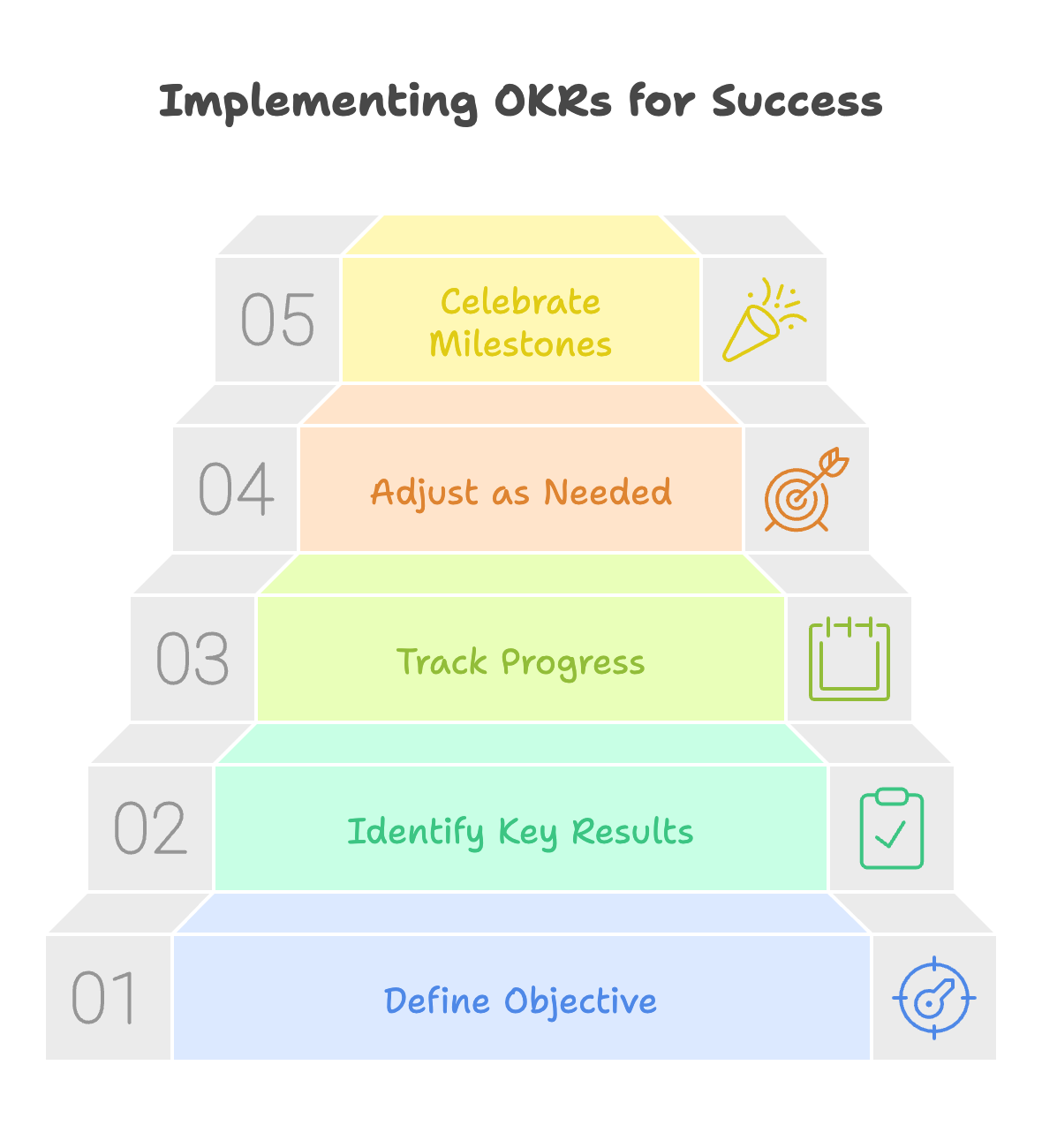In today’s fast-paced world, staying productive is not just a preference… it’s a necessity. Whether you’re an entrepreneur juggling multiple projects or a professional aiming to meet tight deadlines, mastering productivity methods can transform how you work and achieve your goals. But where do you begin?
The truth is, productivity isn’t a one-size-fits-all concept. Different productivity methods cater to different styles, challenges, and objectives. In this article, we delve into 11 powerful productivity methods that can revolutionize your approach to work. From time-tested techniques like the Pomodoro Technique and SMART Goals to modern frameworks like the Commitment Inventory and OKRs, you’ll find actionable steps and insights tailored to help you excel.
Why Productivity Methods Matter
Productivity isn’t just about doing more; it’s about doing what matters most. The right productivity methods help you focus on high-value tasks, manage your time effectively, and maintain balance in your professional and personal life. Think of productivity methods as the tools in a well-equipped toolkit, each designed to tackle specific challenges.
For instance, if procrastination is your nemesis, strategies like “Eat the Frog” or the Pomodoro Technique can help you break the cycle. If you struggle with managing multiple projects, frameworks like Kanban or Time Blocking can bring clarity and order. By understanding and implementing these productivity methods, you’re not just managing your workload—you’re optimizing your life.
As you explore the following productivity methods, consider your unique needs and goals. The journey to peak productivity starts with the willingness to experiment, adapt, and refine your approach.
The Pomodoro Technique: A Popular Productivity Method
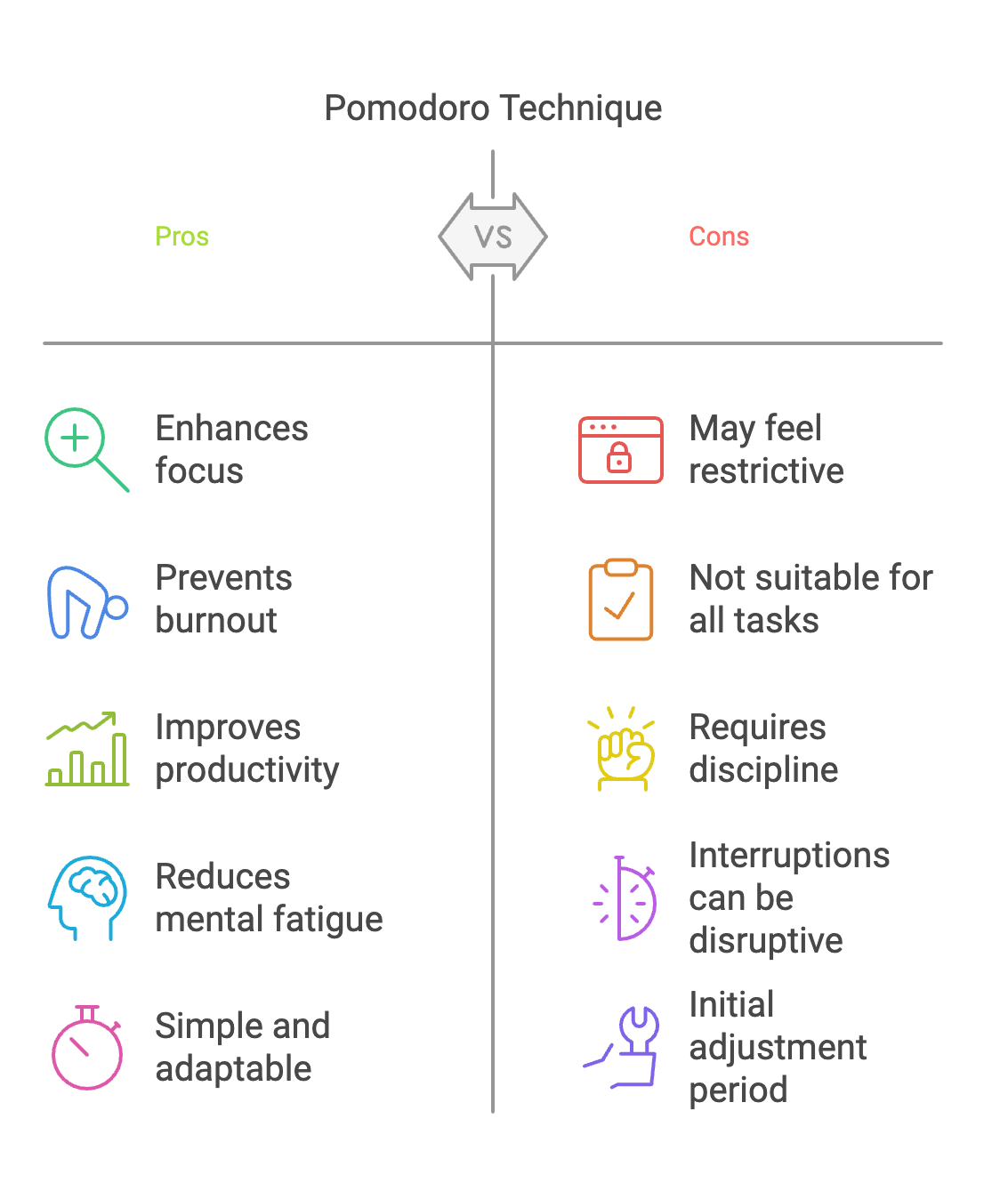
What This Productivity Method Is
The Pomodoro Technique is a time management method that breaks work into intervals, traditionally 25 minutes long, separated by short 5-minute breaks. Developed by Francesco Cirillo in the late 1980s, this technique is designed to enhance focus and prevent burnout.
By working in sprints, you train your brain to concentrate on one task at a time. The structure is simple yet effective, fostering a rhythm that improves productivity and reduces mental fatigue.
The term “Pomodoro” comes from the Italian word for tomato, inspired by Cirillo’s tomato-shaped kitchen timer.
How This Productivity Method Has Been Utilized
Professionals across industries use the Pomodoro Technique to tackle tasks efficiently. Writers use it to draft content without overthinking, while developers employ it to debug code systematically.
Students find it particularly useful for studying, as it helps break down overwhelming workloads into manageable pieces. Remote workers rely on it to stay disciplined and maintain boundaries in flexible environments.
Some companies integrate Pomodoro into team workflows, using it during collaborative sessions to enhance focus and energy.
Action Steps for Using the Pomodoro Technique
- Choose a task to work on.
- Set a timer for 25 minutes and work until it rings.
- Take a 5-minute break.
- After completing four Pomodoros, take a longer 15–30 minute break.
- Repeat the cycle as needed.
Tips for Mastering This Productivity Method
- Use a dedicated timer app to avoid distractions.
- Start with shorter intervals if 25 minutes feels too long.
- Use breaks for physical movement or relaxation.
- Reflect on your progress after each Pomodoro session.
Summary of the Pomodoro Productivity Method
The Pomodoro Technique leverages timeboxing to keep you engaged and productive. Its simplicity and adaptability make it a go-to for anyone looking to enhance their efficiency.
The Eisenhower Matrix: Prioritization Made Simple
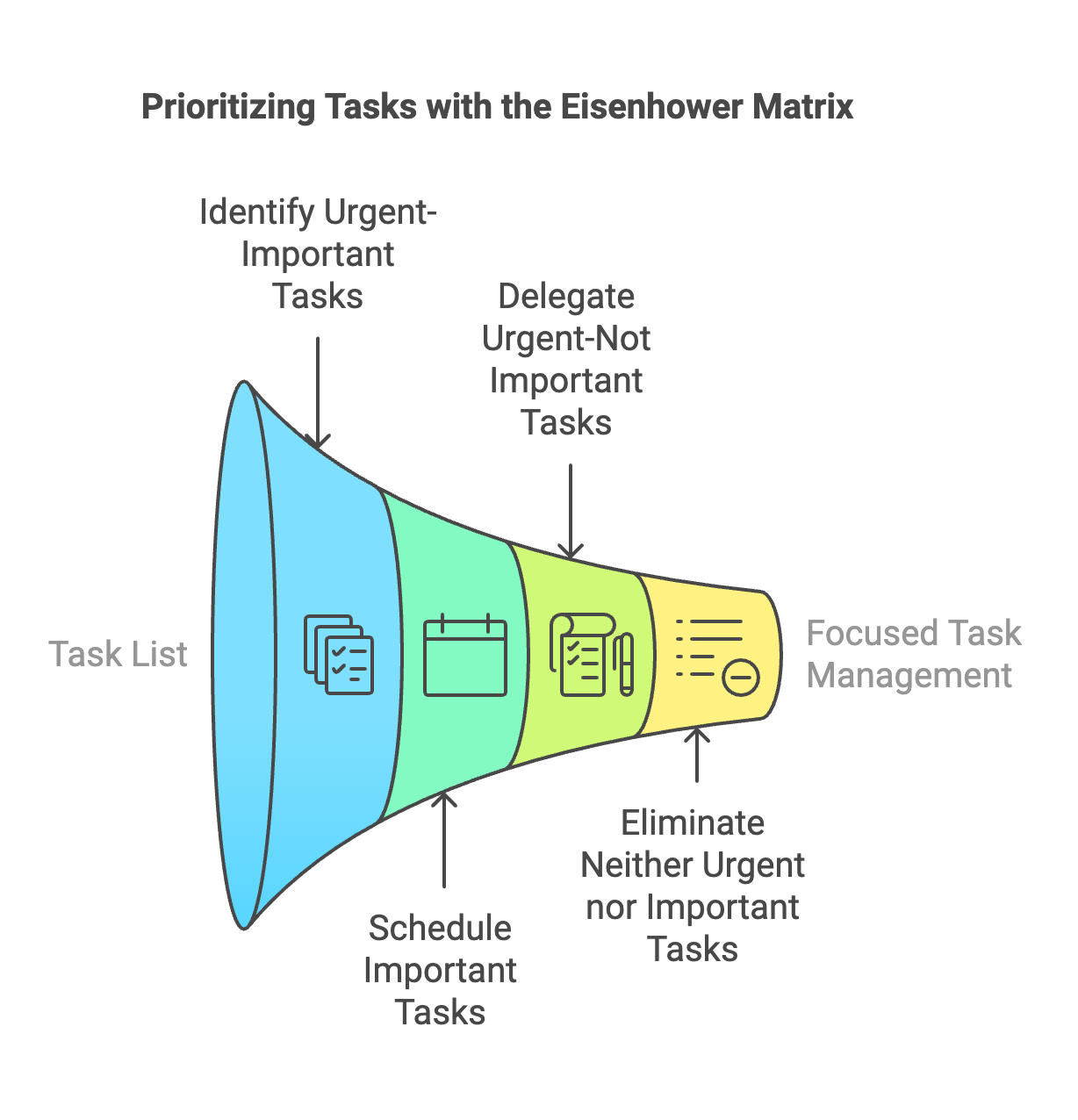
What This Productivity Method Is
The Eisenhower Matrix, also known as the Urgent-Important Matrix, is a decision-making framework that helps prioritize tasks based on urgency and importance. Named after former U.S. President Dwight D. Eisenhower, it categorizes tasks into four quadrants.
This visual tool assists in identifying what requires immediate attention and what can be delegated or postponed, ensuring your time is spent effectively.
The four quadrants are:
- Urgent and Important: Do immediately.
- Important but Not Urgent: Schedule for later.
- Urgent but Not Important: Delegate.
- Neither Urgent nor Important: Eliminate.
How This Productivity Method Has Been Utilized
Entrepreneurs and executives use the Eisenhower Matrix to streamline decision-making. It’s a staple for project managers juggling competing priorities.
Students employ it to balance academics, extracurriculars, and personal commitments. Nonprofit leaders use it to allocate resources effectively and focus on mission-critical tasks.
In personal life, it’s helpful for prioritizing errands, appointments, and long-term planning.
Action Steps for Using the Eisenhower Matrix
- List all your tasks for the day.
- Assign each task to one of the four quadrants.
- Take immediate action on tasks in the first quadrant.
- Schedule tasks in the second quadrant.
- Delegate or eliminate tasks in the third and fourth quadrants.
Tips for Using This Productivity Method Effectively
- Reevaluate tasks periodically to adjust priorities.
- Limit your to-do list to a manageable number of items.
- Use visual aids, like color-coded sticky notes, for clarity.
Summary of the Eisenhower Productivity Method
The Eisenhower Matrix provides clarity in the chaos, helping you make informed decisions and focus on what truly matters.
Objectives & Key Results (OKRs): A Strategic Productivity Framework
What This Productivity Method Is
OKRs are a goal-setting framework that align objectives (what you want to achieve) with measurable key results (how you’ll measure success). Popularized by companies like Google, OKRs drive focus and accountability.
The framework is adaptable for teams and individuals, fostering alignment across all levels of an organization. Objectives are ambitious yet achievable, while key results are specific, measurable, and time-bound.
How OKRs Have Been Utilized as a Productivity Method
Tech giants like Intel and LinkedIn attribute their success to OKRs. Teams use them to align efforts across departments and track progress transparently.
Startups use OKRs to establish a clear vision and motivate teams during rapid growth phases. Nonprofits apply them to track impact metrics and operational goals.
Individuals use OKRs for personal development, such as fitness milestones or learning goals.
Action Steps for Using OKRs
- Define your objective: What do you want to achieve?
- Identify 3–5 key results for each objective.
- Track progress weekly or monthly.
- Adjust objectives or key results as needed based on feedback.
- Celebrate milestones to maintain motivation.
Tips for Leveraging This Productivity Method
- Use software tools like spreadsheets or OKR platforms for tracking.
- Align team OKRs with organizational goals for cohesion.
- Keep objectives ambitious but realistic.
Summary of OKRs as a Productivity Method
OKRs provide a structured approach to goal-setting that drives alignment and measurable progress, making them indispensable for growth and clarity.
The Medium Method: A Balanced Approach to Productivity
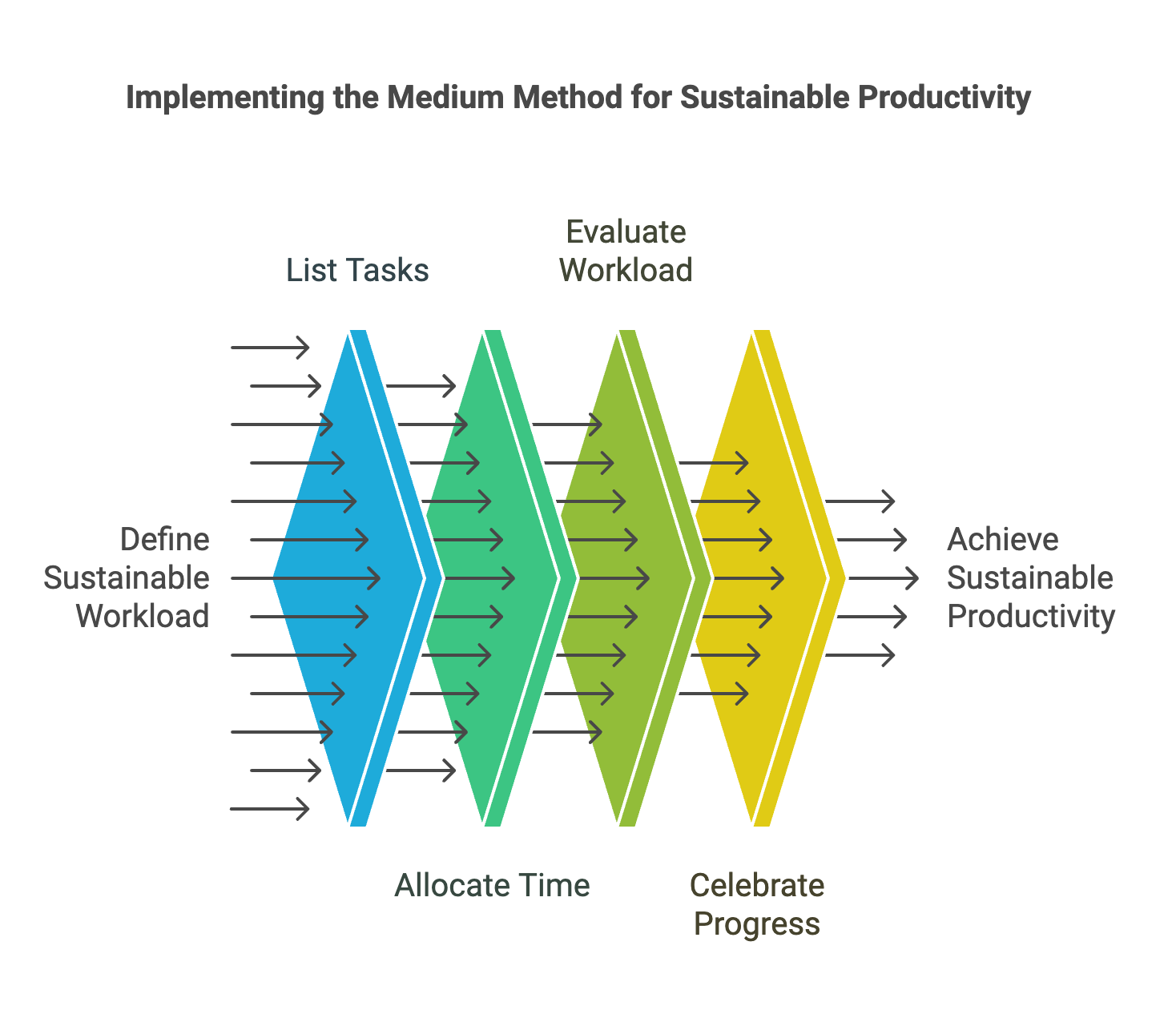
What This Productivity Method Is
The Medium Method focuses on setting a consistent pace for productivity rather than oscillating between extremes of high-intensity work and burnout. It emphasizes balance, aiming for sustainable output over time.
This method encourages prioritizing tasks that align with long-term goals, ensuring you’re always moving forward steadily.
How This Productivity Method Has Been Utilized
Freelancers use the Medium Method to balance client projects without overloading themselves. Creative professionals adopt it to maintain artistic inspiration without succumbing to deadlines.
Corporate teams use this method during sprints, ensuring consistent progress without diminishing morale. Educators implement it to structure lesson plans and grading schedules effectively.
Action Steps for Applying the Medium Method
- Define your medium pace: What workload feels sustainable?
- List tasks and allocate time slots based on your pace.
- Regularly evaluate and adjust your workload.
- Celebrate consistent progress to stay motivated.
Tips for Maximizing This Productivity Method
- Focus on quality over quantity.
- Take breaks to reflect and recharge.
- Use feedback to refine your medium pace.
Summary of the Medium Productivity Method
The Medium Method is about sustainability, ensuring steady progress without sacrificing well-being or quality.
Getting Things Done (GTD): Streamlining Productivity
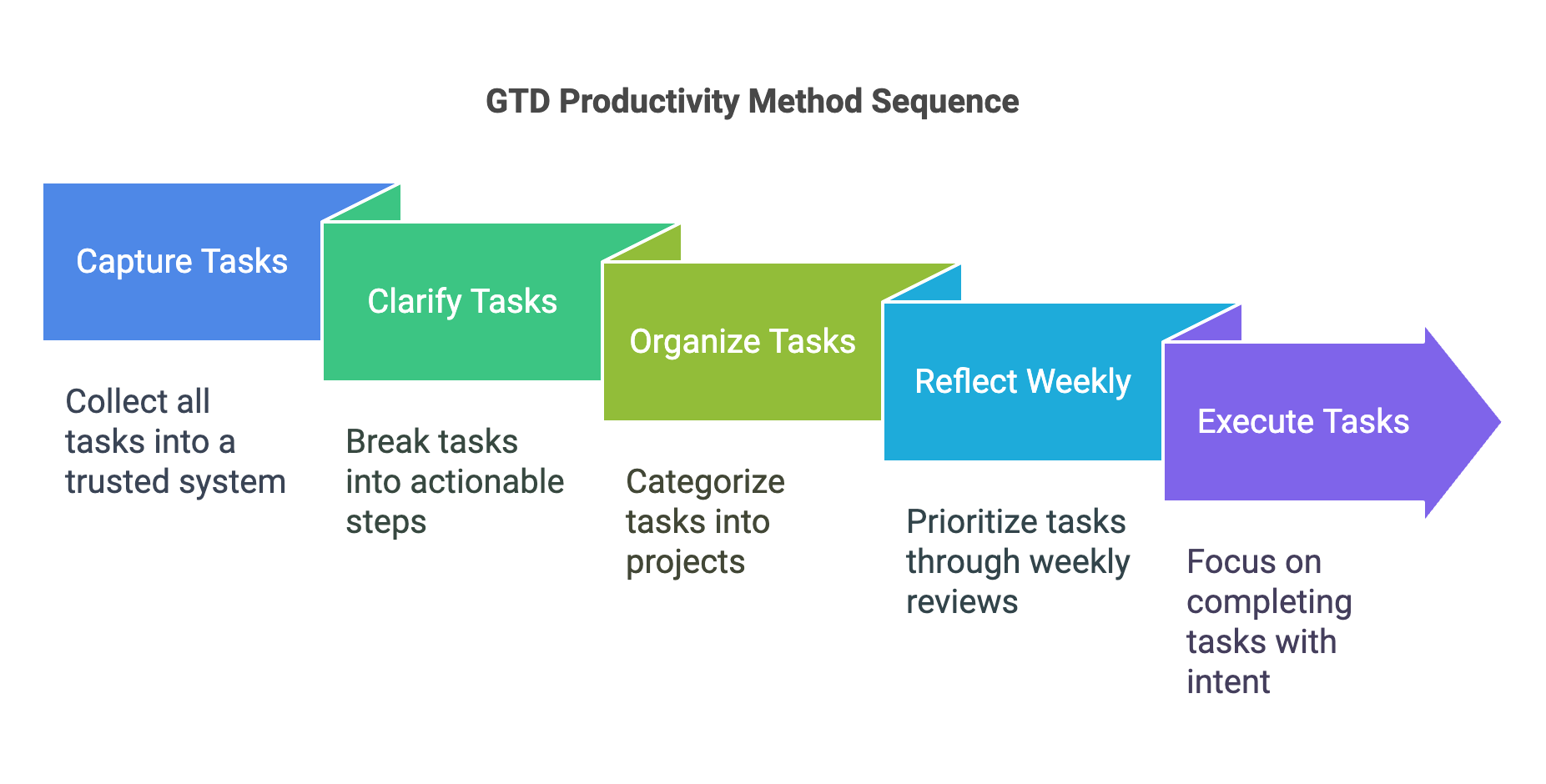
What This Productivity Method Is
GTD is a productivity system developed by David Allen that organizes tasks into actionable steps. It provides a clear process for capturing, clarifying, organizing, and executing tasks.
By externalizing your to-do list, GTD frees mental bandwidth and promotes a sense of control over your responsibilities.
How This Productivity Method Has Been Utilized
Professionals use GTD to manage complex projects with multiple moving parts. Students adopt it for organizing study schedules and assignments.
Small business owners rely on GTD to balance operations, marketing, and client management. Families use it for chore distribution and event planning.
Action Steps for Using the GTD Method
- Capture all tasks in a trusted system (digital or physical).
- Clarify tasks by breaking them into actionable steps.
- Organize tasks into categories or projects.
- Reflect weekly to prioritize tasks.
- Execute tasks with focus and intent.
Tips for Mastering This Productivity Method
- Use tools like Trello or Notion for organization.
- Set aside time daily for capturing and clarifying tasks.
- Stay flexible and adapt the system as needed.
Summary of the GTD Productivity Method
GTD transforms overwhelming to-do lists into manageable actions, fostering clarity and confidence in daily tasks.
Kanban: A Visual Approach to Productivity Methods
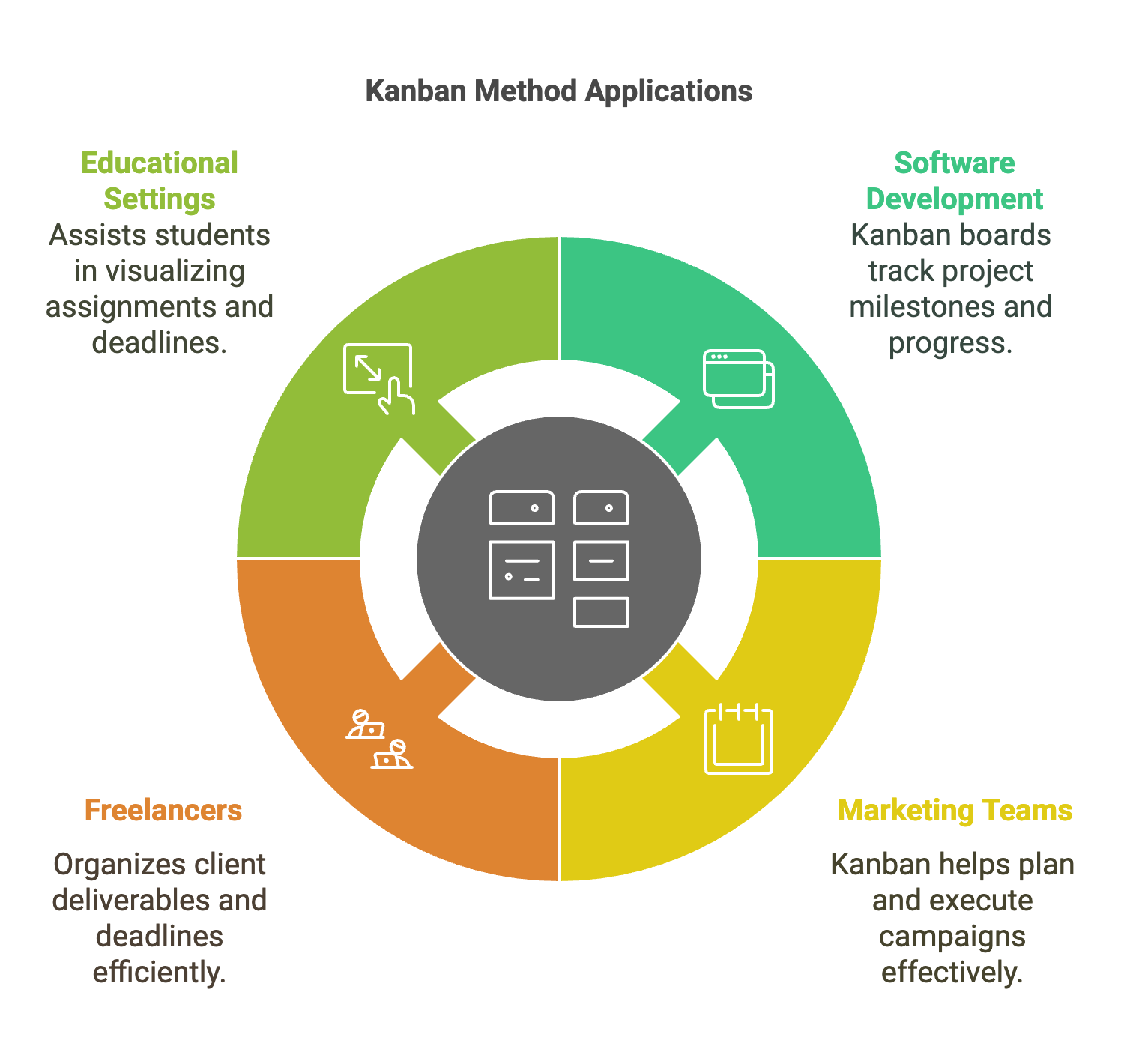
What This Productivity Method Is
Kanban is a visual workflow management method that helps teams and individuals track tasks through a board system. Originating from manufacturing, it uses columns to represent stages in a process, such as “To Do,” “In Progress,” and “Completed.”
This method focuses on limiting work in progress to avoid bottlenecks and ensure efficiency.
How This Productivity Method Has Been Utilized
Kanban boards are widely used in software development to track project milestones. Marketing teams employ them to plan campaigns and content calendars.
Freelancers use Kanban to organize client deliverables and deadlines. Teachers implement it in classrooms to help students visualize assignments and deadlines.
Action Steps for Using Kanban
- Create a Kanban board with columns for task stages.
- Add tasks to the board and move them through stages as work progresses.
- Set limits on tasks in the “In Progress” column to maintain focus.
- Regularly review and update the board.
Tips for This Productivity Method
- Use digital tools like Trello or physical boards for flexibility.
- Color-code tasks for better visual organization.
- Review completed tasks to celebrate progress and identify improvements.
Summary of the Kanban Productivity Method
Kanban enhances productivity by making workflows transparent and manageable. Its adaptability makes it suitable for teams and individuals alike.
Time Blocking: Structure Your Day for Productivity
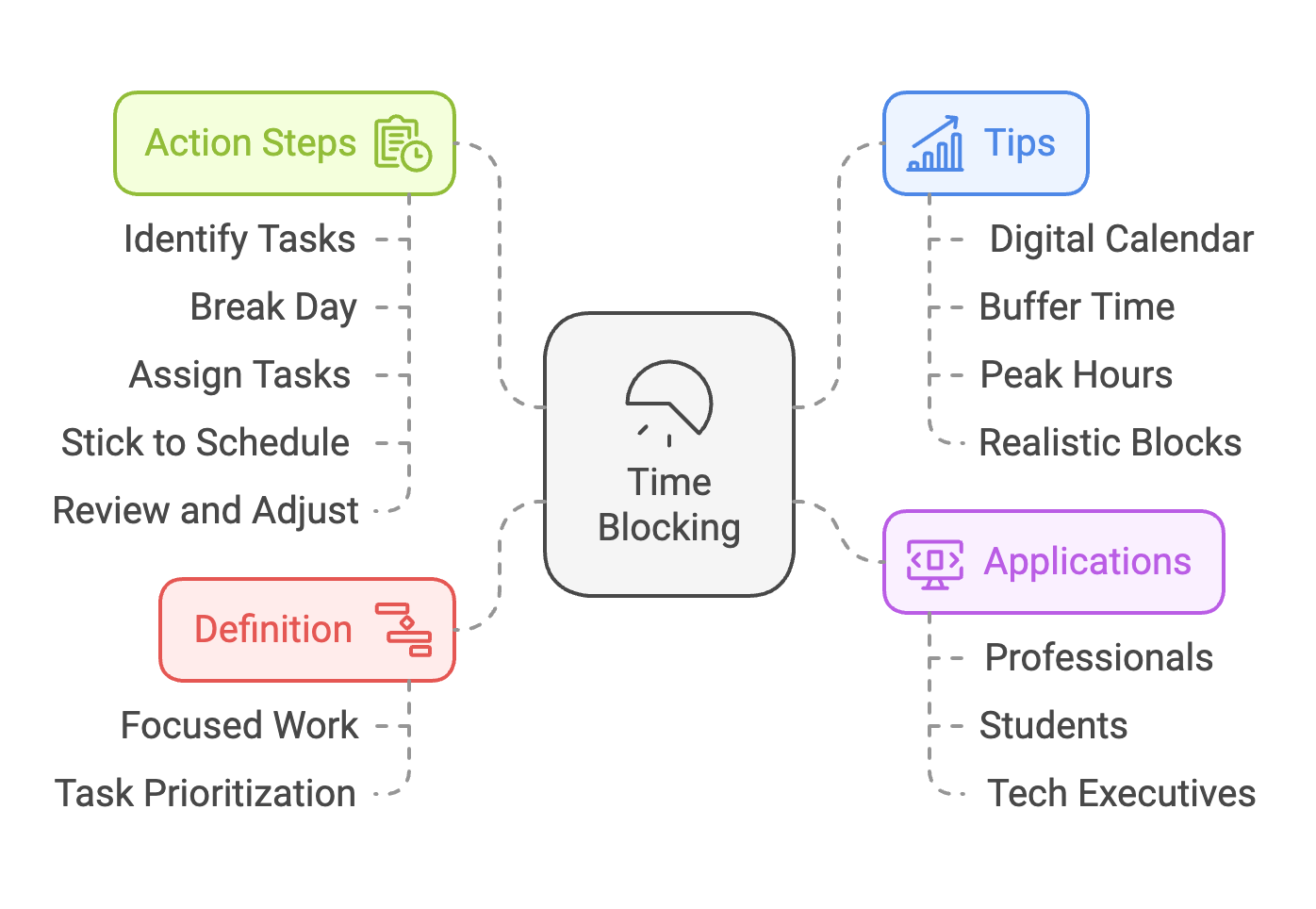
What This Productivity Method Is
Time blocking is a productivity method that involves scheduling specific blocks of time for individual tasks or activities. Instead of working from a general to-do list, time blocking requires you to assign a specific time slot to each task, ensuring focused and intentional work periods.
The technique fosters a structured approach to managing your day. By dedicating fixed time slots to important tasks, you create a roadmap that prioritizes what matters most. This approach minimizes distractions and reduces decision fatigue by pre-planning your schedule.
Unlike multitasking, time blocking emphasizes single-task focus, allowing you to immerse yourself fully in one task at a time. This enhances both efficiency and the quality of your work.
How Time Blocking Has Been Utilized as a Productivity Method
Time blocking is widely used by professionals who juggle multiple responsibilities. Entrepreneurs rely on this method to carve out dedicated time for strategic thinking, team meetings, and client interactions without letting smaller tasks consume their day.
Students benefit from time blocking by allocating specific hours for studying, assignments, and breaks. It helps them maintain a healthy balance between academic responsibilities and personal life.
Tech executives like Elon Musk have famously used time blocking to manage their packed schedules, demonstrating how the method ensures that even the busiest professionals can remain productive and focused.
Action Steps for Time Blocking
- Identify all tasks and activities you need to complete.
- Break your day into time slots (e.g., 30 minutes, 1 hour).
- Assign each task to a specific time block on your calendar.
- Stick to the schedule as closely as possible.
- Regularly review and adjust your time blocks based on your priorities.
Tips for Leveraging This Productivity Method
- Use a digital calendar for flexibility and easy adjustments.
- Reserve buffer time between blocks for unexpected interruptions.
- Prioritize high-energy tasks during your peak productivity hours.
- Keep your time blocks realistic to avoid overloading your schedule.
Summary of the Time Blocking Productivity Method
Time blocking transforms your day into a structured plan, ensuring that each hour is utilized effectively. By aligning your tasks with your available time, you can stay organized, productive, and focused on your goals.
Eat The Frog: Conquer Your Day’s Biggest Challenges
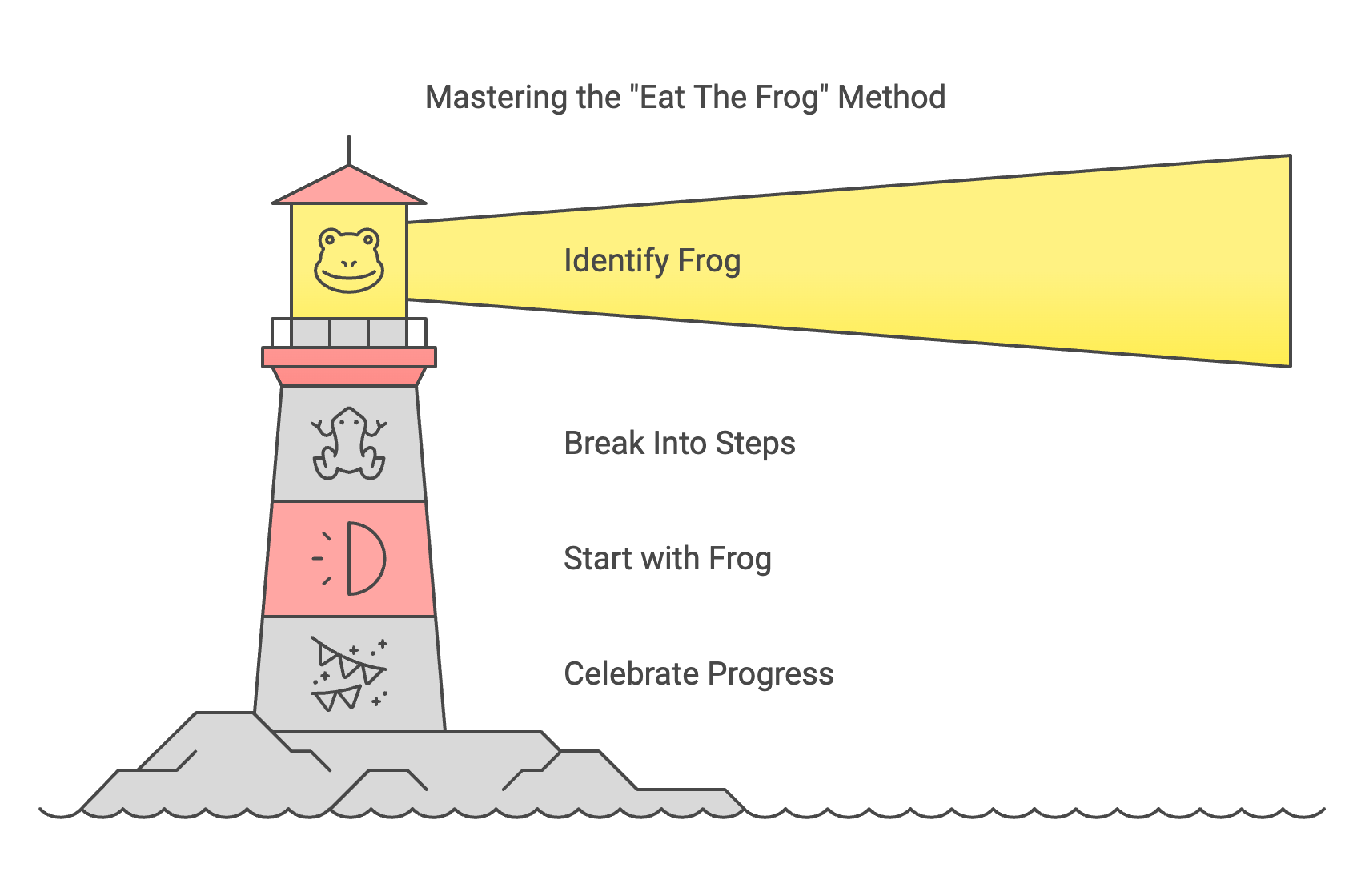
What This Productivity Method Is
“Eat The Frog” is a productivity philosophy inspired by Mark Twain’s saying: “If it’s your job to eat a frog, it’s best to do it first thing in the morning.” The “frog” symbolizes your most important and challenging task—the one you’re most likely to procrastinate on.
The method encourages tackling your biggest and most crucial task at the start of your day. By addressing the “frog” early, you set a positive tone for the rest of your day and eliminate the lingering stress of an uncompleted critical task.
How This Productivity Method Has Been Utilized
Professionals across industries use this technique to overcome procrastination. Writers begin their day by completing a chapter or an article, knowing it’s their most mentally taxing task.
Managers use it to address critical decision-making tasks, ensuring that they don’t get bogged down by less important duties. Entrepreneurs often “eat the frog” by tackling strategic challenges like investor presentations or team restructuring.
This method is particularly useful for anyone with a tendency to procrastinate, as it forces focus on what truly matters.
Action Steps for Using the Eat The Frog Method
- Identify your “frog”—the most important and difficult task of the day.
- Break the task into smaller, manageable steps if necessary.
- Start your workday by addressing this task before moving on to anything else.
- Celebrate your progress once the task is completed.
Tips for Mastering This Productivity Method
- Eliminate distractions before starting your “frog.”
- Pair the method with time blocking to ensure dedicated focus.
- Avoid overloading your schedule with multiple “frogs”—focus on one main task.
- Reward yourself for completing your “frog” to reinforce the habit.
Summary of the Eat The Frog Productivity Method
The “Eat The Frog” method is a straightforward yet powerful strategy to conquer procrastination and ensure your most critical task gets done. Starting your day with your “frog” builds momentum and sets the stage for a productive day.
SMART Goals: Setting Goals That Drive Productivity
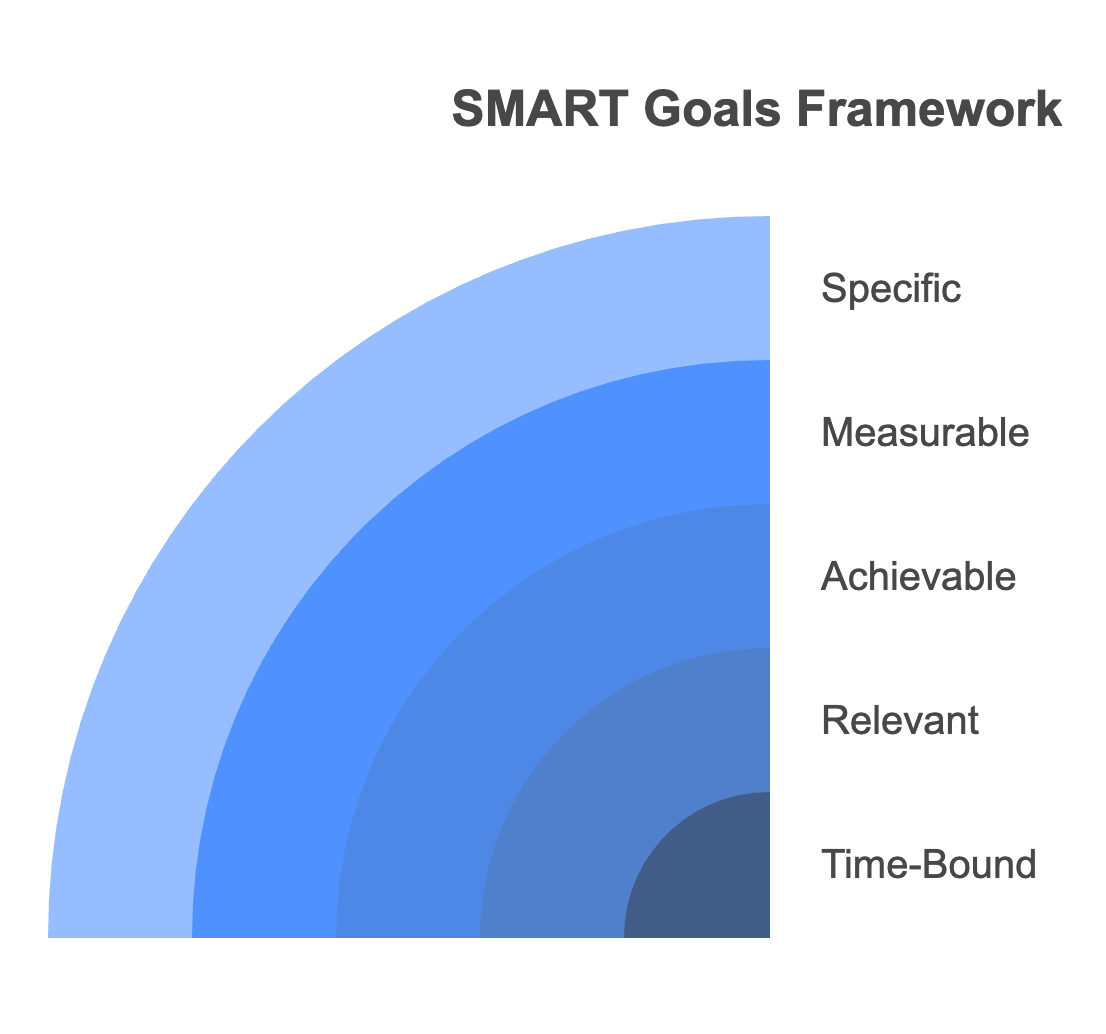
What This Productivity Method Is
SMART is an acronym that stands for Specific, Measurable, Achievable, Relevant, and Time-Bound. It is a goal-setting framework that ensures your objectives are clear, actionable, and attainable.
This method transforms vague aspirations into concrete plans by outlining exactly what you want to achieve, how you’ll measure success, and when you’ll accomplish it. By following the SMART criteria, you create goals that are motivating and aligned with your broader objectives.
How This Productivity Method Has Been Utilized
Businesses use SMART goals to align teams around clear objectives, such as increasing quarterly revenue by 15% or launching a new product by a set deadline. Educators implement SMART goals for academic milestones, helping students achieve measurable progress.
Individuals use the framework for personal aspirations, like improving fitness levels or mastering a new skill. The method’s clarity ensures steady progress and minimizes the risk of losing focus.
Action Steps for Setting SMART Goals
- Define your goal in specific terms (e.g., “Increase website traffic by 20%”).
- Establish measurable metrics to track success.
- Ensure the goal is realistically achievable given your resources.
- Confirm the goal is relevant to your larger mission or priorities.
- Set a clear deadline to create urgency.
Tips for Leveraging This Productivity Method
- Regularly review your progress to stay on track.
- Break larger goals into smaller SMART sub-goals.
- Adjust goals as circumstances evolve, but maintain focus.
- Celebrate milestones to maintain motivation.
Summary of the SMART Goals Productivity Method
SMART goals transform ambitions into actionable steps. By creating clear, measurable, and time-bound objectives, this framework empowers you to achieve meaningful results with precision and focus.
The Weekly Review: Reflect and Plan for Better Productivity
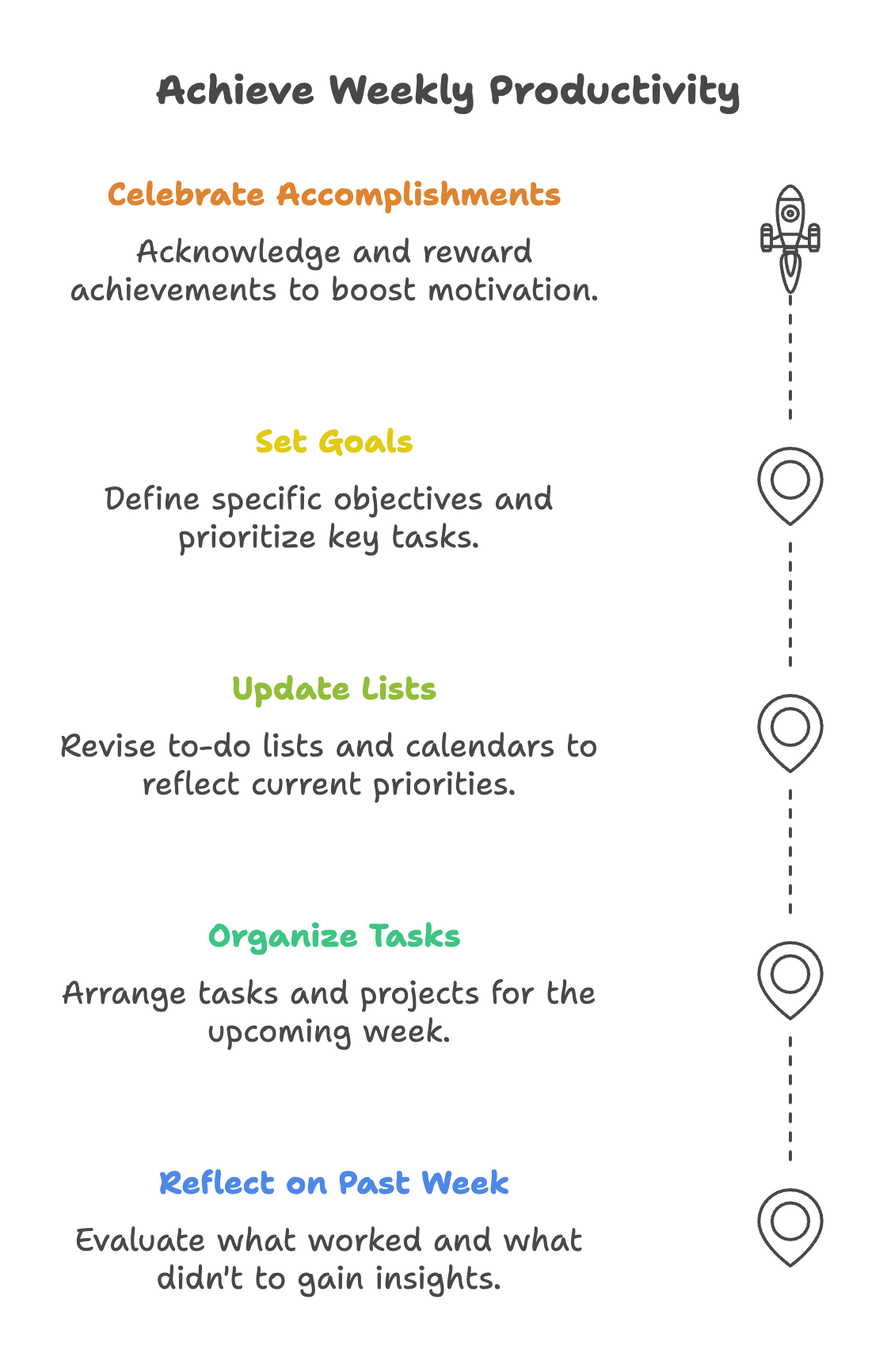
What This Productivity Method Is
The Weekly Review is a reflective practice designed to evaluate your past week, organize your current tasks, and plan for the week ahead. It ensures you stay aligned with your goals and maintain control over your commitments.
This method promotes accountability and consistency by providing a dedicated time to assess progress, address challenges, and adjust priorities.
How This Productivity Method Has Been Utilized
Executives use the Weekly Review to manage their schedules and stay proactive about upcoming deadlines. Project managers conduct reviews to ensure their teams remain aligned and productive.
Freelancers adopt this practice to balance client work and personal projects, while students use it to track academic progress and prepare for exams.
Action Steps for Conducting a Weekly Review
- Reflect on the past week: What worked? What didn’t?
- Organize tasks and projects for the coming week.
- Update your to-do lists and calendars.
- Set specific goals and prioritize key tasks.
- Celebrate accomplishments to build motivation.
Tips for This Productivity Method
- Schedule a consistent time for your review (e.g., Sunday evening).
- Use a dedicated notebook or app to track reflections.
- Keep your review concise but thorough.
- Involve team members for collaborative planning sessions.
Summary of the Weekly Review Productivity Method
The Weekly Review fosters self-awareness and proactive planning, ensuring you remain focused and organized. It’s a cornerstone practice for long-term productivity and success.
The Commitment Inventory: Aligning Goals and Priorities
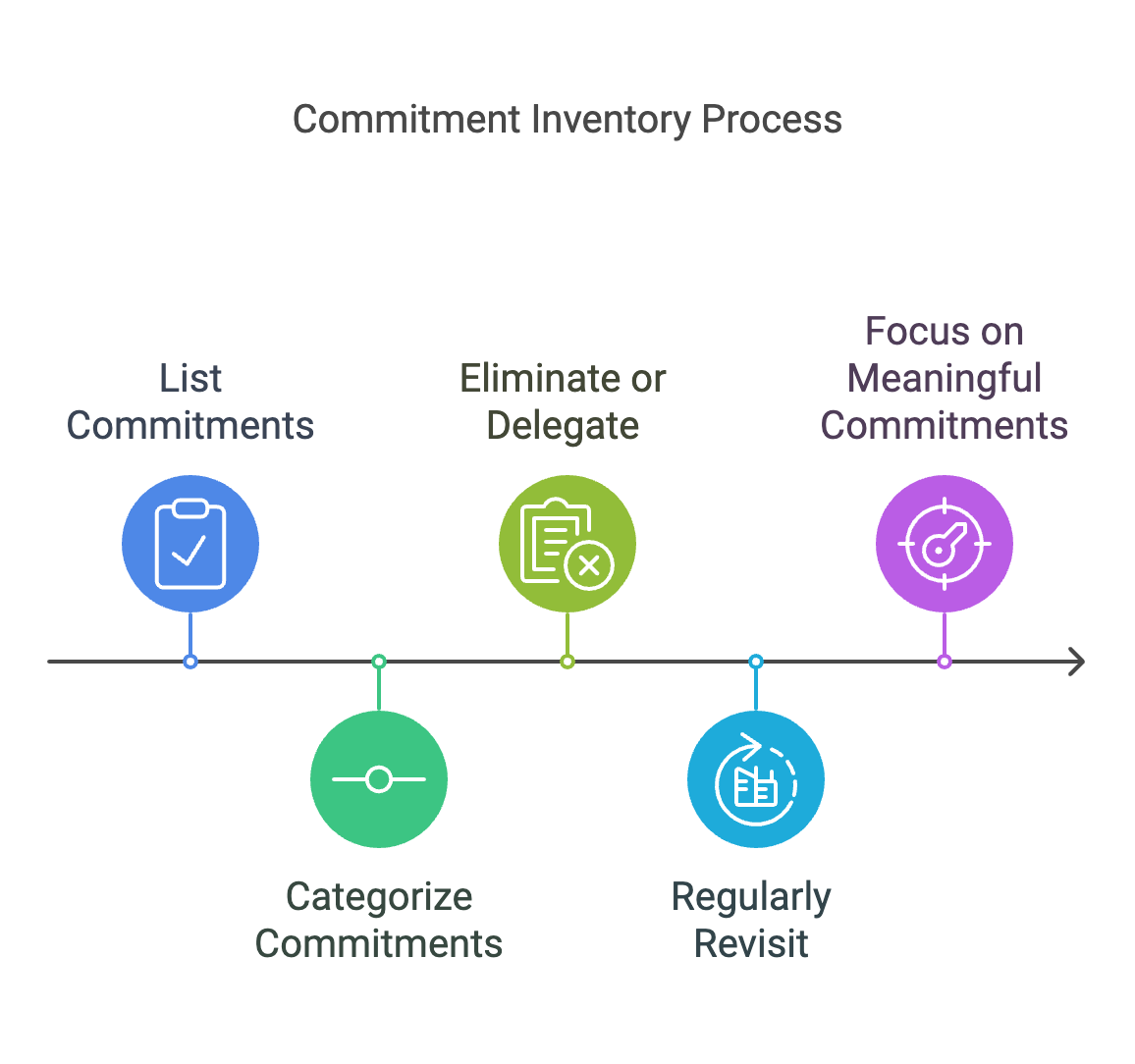
What This Productivity Method Is
The Commitment Inventory involves listing all your obligations, tasks, and responsibilities to assess whether they align with your goals and values. It helps identify unnecessary commitments and ensures your energy is directed toward meaningful pursuits.
This method is a reality check, forcing you to confront overcommitment and make intentional choices about where to invest your time and effort.
How This Productivity Method Has Been Utilized
Busy professionals use the Commitment Inventory to declutter their schedules and focus on high-priority tasks. Entrepreneurs rely on it to identify areas where delegation is necessary.
Nonprofit leaders use this approach to balance mission-critical activities with resource constraints. Parents adopt it to manage family commitments while pursuing personal goals.
Action Steps for Using the Commitment Inventory
- Create a comprehensive list of all your commitments.
- Categorize commitments by importance and relevance.
- Eliminate or delegate low-priority tasks.
- Regularly revisit the inventory to adjust as needed.
- Focus on commitments that align with your values and objectives.
Tips for This Productivity Method
- Be honest and thorough when listing commitments.
- Use color-coding to visually prioritize tasks.
- Seek input from trusted colleagues or mentors for perspective.
- Schedule regular check-ins to refine your inventory.
Summary of the Commitment Inventory Productivity Method
The Commitment Inventory is a powerful tool for regaining control of your time. By focusing on meaningful commitments and eliminating distractions, it enhances both productivity and personal fulfillment.
Choosing Your Path to Productivity
After exploring these 11 transformative productivity methods, one thing becomes clear: there is no universal best method. The effectiveness of a strategy depends on your individual circumstances, goals, and preferences. What works wonders for one person might not resonate with another—and that’s perfectly okay.
Putting It All Together
Start small. Choose one or two productivity methods that align with your immediate needs and give them a fair trial. For instance, if you’re constantly overwhelmed by your to-do list, try Time Blocking or Getting Things Done (GTD). If big-picture thinking is your priority, Objectives & Key Results (OKRs) might be your best bet.
Track your progress and don’t hesitate to adjust as you go. Productivity is a dynamic process, and flexibility is key to sustaining success. Over time, you’ll build a personalized productivity system that empowers you to achieve more with less stress.
Your Next Steps
Remember, productivity is not just about ticking boxes—it’s about creating meaningful progress toward your goals. By integrating these productivity methods into your daily routine, you’re setting the stage for long-term success and fulfillment.
Ready to take control of your time and energy? Dive into the productivity methods detailed above and find the ones that resonate with you. Let today be the start of a more focused, efficient, and rewarding journey.

